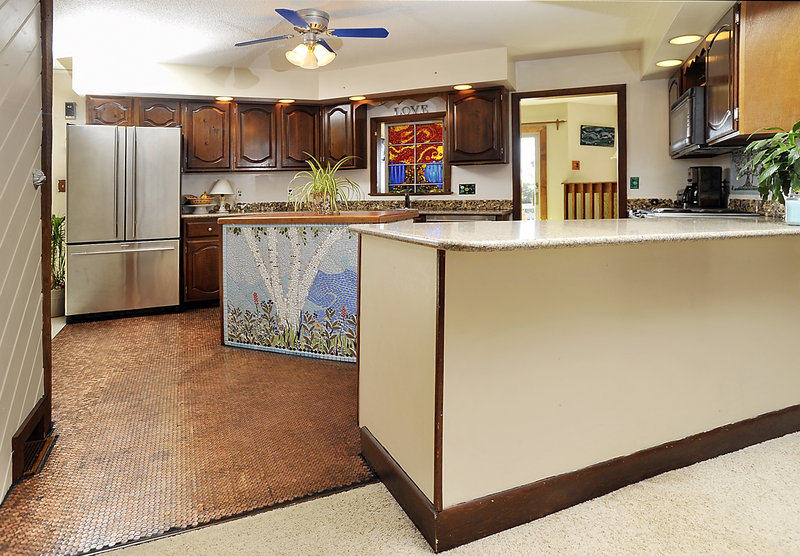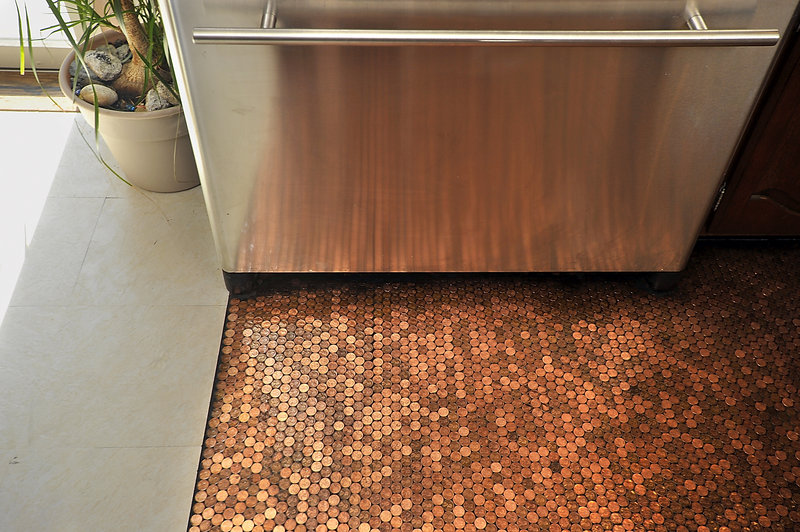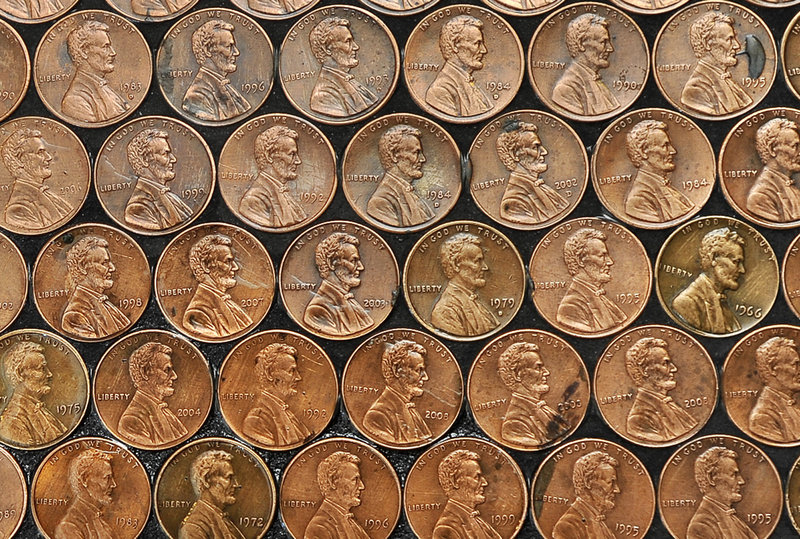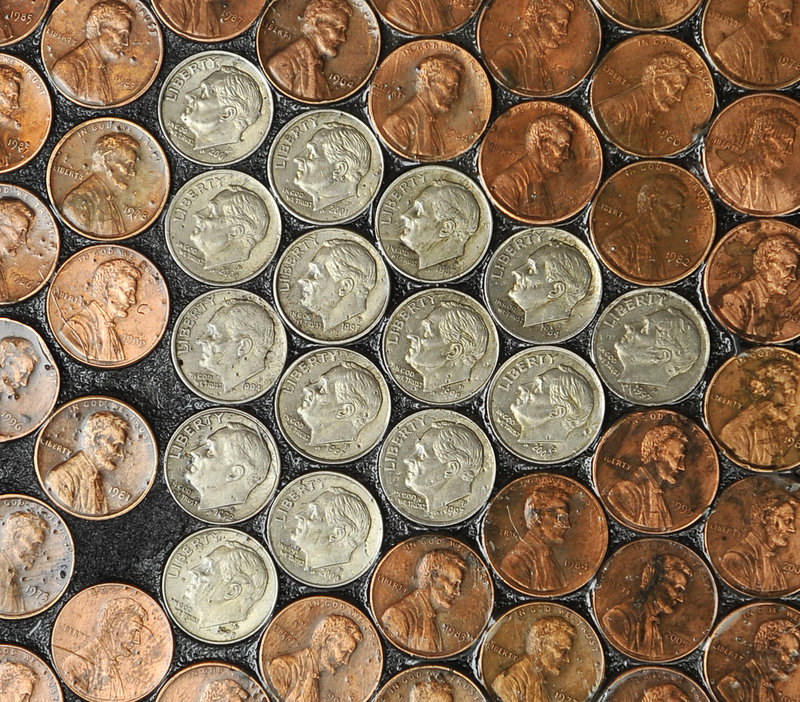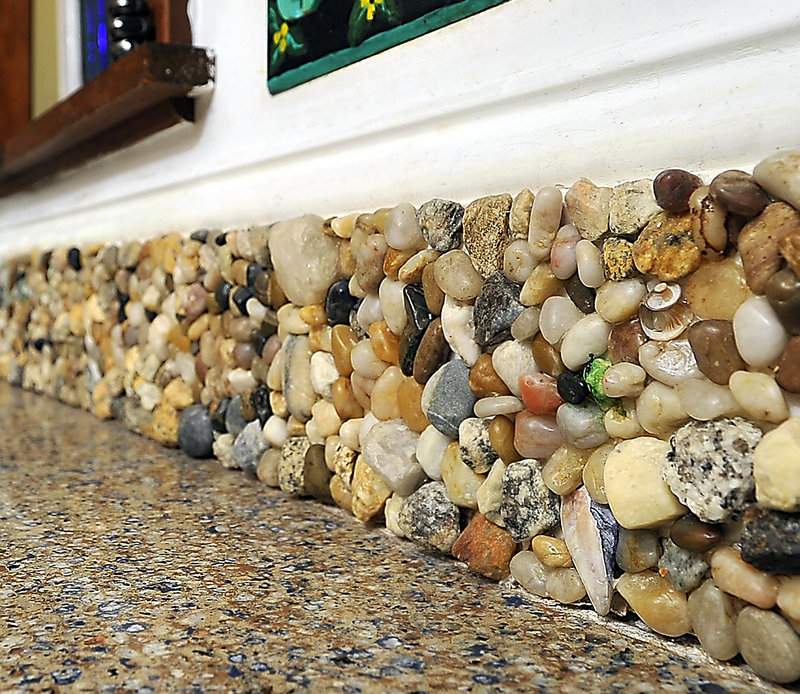FALMOUTH – When Amanda Edwards told her 8-year-old son that someone wanted to take a picture of their kitchen floor, he was surprised.
“I told him that it was unusual — not everyone uses pennies to cover their kitchen floor,” said Edwards, 36. “He said, ‘Do most people use quarters?’ “
Being a mosaic artist, Edwards is constantly doing home improvements that involve covering things up with little pieces of something else. She’s got a mosaic of cut stained glass over her kitchen counter, and a pastoral nature scene of colored tile on her kitchen island.
So her family wasn’t very surprised a year and a half ago when she decided to cover the faux-brick linoleum in their 1970s ranch house with pennies.
But to anyone else who sees the finished floor — with an estimated 31,000 pennies, all face up and with Abraham Lincoln facing the same direction — the work is stunning.
At first glance, the floor seems like it’s merely a covering of some sort with a coppery, shiny dot pattern. But once you get a little closer and see the individual pennies — with a seemingly endless variety of copper shades — it’s hard to stop looking.
“When the sun hits it just right, this floor just glows,” said Edwards.
The penny floor idea came to Edwards while she was trying to find a way to warm up the color of her living room walls. One of her ideas was to cover one wall with copper sheeting. But when she priced it, she found that buying copper in sheets was too expensive for her budget.
“I joked that it would be cheaper to just cover the whole wall in pennies,” said Edwards. “But then I thought, maybe I could use pennies. The wall might be too hard, but I started thinking about what else I could cover in pennies.”
Once she settled on pennies, she began to work the way she would on other mosaics. First, she got her material — her pennies. She went to the bank — almost daily at some points — to get hundreds of them. She wanted clean pennies, as clean as possible.
So some days, when she went to get a sack of pennies, she brought other pennies back with her to be exchanged.
“I’d go in and tell them the pennies were too dirty and I wanted cleaner ones,” said Edwards. “They looked at me kind of funny, so at some point I had to tell them what I was doing.”
Edwards bought some wax remover at Home Depot to get the linoleum as smooth as possible. Then she got gallons of Weldbond glue, the same stuff she uses for tile or glass mosaics. She sat on the floor, dabbed a little glue on the tails side of the pennies, and stuck them to the floor.
Once she had an area covered with pennies, Edwards would cover it with a brownish grout. Then she’d wipe the grout in a circular motion until it was no longer covering the pennies, but merely sitting in the spaces between them. The grout forms a nice dark background to the pennies.
Once she finished covering the whole floor with pennies (and a few dimes here and there), she used a couple coats of polyurethane to protect it. The polyurethane makes the floor easy to clean, Edwards says, as easy as any non-wax floor. It also makes the floor smooth to walk on. Walking in socks on the floor, it’s almost impossible to feel individual coins.
It does, however, feel a little cold, as one might expect.
“In the summer, it’s nice and cool, cooler than tile,” said Edwards, standing on the floor in bare feet in early April.
One challenge Edwards had was keeping all the heads facing the same direction — something she didn’t have to do, but thought would make for a better overall look.
The 10- by 11-foot kitchen is open to the living and dining areas, and is shaped roughly like a triangle. Plus, there’s an island in the middle.
So she had to start putting down pennies at one end and work her way around to make sure no two coins would be heading in different directions.
She did it in sections, closing down portions of the kitchen for a few days at a time. It took her about a year and a half to complete.
After it was done, Edwards and her family — husband Matthew and children Julian, 8, and Priya, 5 — wanted to know how many pennies were used.
They sent the kitchen’s measurements to the Massachusetts Institute of Technology in Cambridge and asked for an estimate. The answer they got was 31,140.
While covering a kitchen floor with pennies is not for everyone, Edwards does have at least one home-decor mosaic idea that is easy and would have appeal for many families.
The backsplash behind her kitchen counters — a long piece of board about 5 or 6 inches high — is covered with pebbles, sea glass, shells and other things her children have collected on trips to the beach.
She installed the board, got some more Weldbond glue, and began sticking up the found treasures. Many families have buckets of shells and sea glass in the backyard.
“This way, I can look at that sand dollar right there and remember that Julian got that with his grandma,” said Edwards. “It’s a way my children can contribute to make the kitchen ours.”
To learn more about Edwards and see her work, go to mandolinmosaics.com.
Staff Writer Ray Routhier can be contacted at 791-6454 or at:
rrouthier@pressherald.com
Send questions/comments to the editors.


